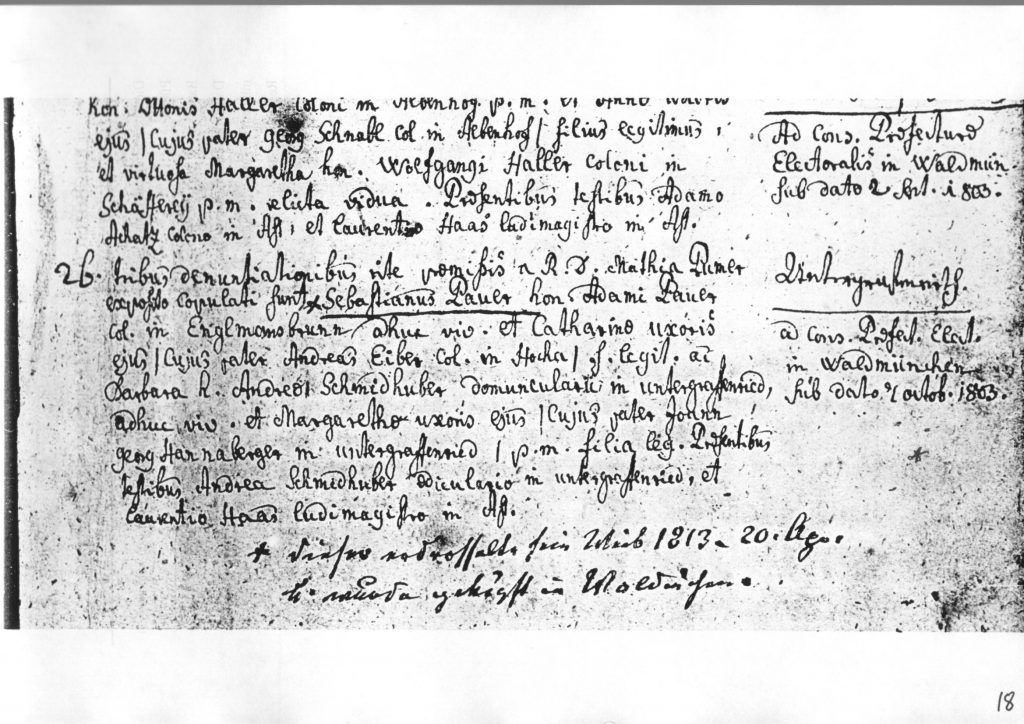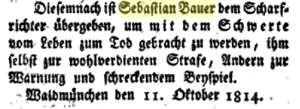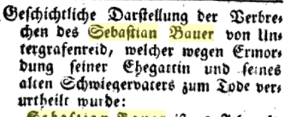Disclaimer: This post is meant to share a piece of my client’s family history that he was kind enough to share – as well as to show how his different research methods can pay off. I absolutely do not condone or wish to glorify the actions taken by Sebastian Bauer in any way, shape, or form. – Katherine Schober
My Ancestor, the Serial Killer: A Story from Gary Haas
Sometimes there are extra notes scribbled in at the top or the bottom of your ancestor’s document. Usually rather small and written seemingly haphazardly, these comments can be rather daunting to translate, and it may be tempting to ignore them. But if you do decide to find out what they mean, you may just discover extremely juicy details of your ancestor’s past…
Gary, a retired accountant and family history researcher, did not ignore those scribbled two lines at the bottom of his ancestor’s marriage record. And he was very surprised by what he found.

Let’s Start at the Beginning…
Gary’s ancestors comes from Waldmünchen, Bavaria, Germany – and there are unfortunately few Catholic church records from there that have been digitized. Plus, the best documents about his ancestors were in German…for which he had limited skills. Gary knew that if he wanted to advance his family history, he would need to find a professional researcher who could locate the documents in Germany and who could translate them for him once she did.
Finding a Researcher…
On his quest for a researcher, Gary went on a trip to the Family History Library in Salt Lake City, Utah. There, he was able to find and hire an internationally-known researcher who volunteered at the library. She was born in Germany, German was her first language, she could read the German script, and she made periodic research trips to Germany. Just what he was looking for!
Over in Germany…
Once over in Germany, the researcher started searching the Catholic diocese’s archives in Regensburg, Bavaria, Germany. There, she happened to find an 1803 document on the wedding of his 4x-great-grandparents, Sebastian Bauer and Barbara Schmidhuber, from Ast, Bavaria, near the Bohemian border. But the document did a bit more than just report on their marriage…
The Big Reveal…
While most of the handwriting on this document looked clear to Gary, the two lines at the bottom of the document were a scrawl – but they piqued his interest.

Luckily, the researcher was able to translate the priest’s extra comment at the bottom of the page – and you’ll never guess what it said:
Dieser erdrosselte sein Weib 1813 – 20. Apr. u. wurde geköpft in Waldmünchen.
In case you don’t speak German, this translates to:
This man strangled his wife on April 20, 1813 and was beheaded in Waldmünchen.
Well, that’s not something you find every day. Gary knew he had to find out more.
The Research Continues…
Through Google searches, Gary was able to find many articles on Sebastian’s beheading. One search of Google Books (a great resource for everyone – https://books.google.com/) even found a two-page newspaper article describing Sebastian’s confession – a wealth of information!
“Historical account of the crimes of Sebastian Bauer from Untergrafenreid, who was sentenced to death because of the murder of his wife and his old father-in-law:”
Even though Gary does not speak German, he was able to get a rough translation of this Fraktur article using Google Translate by taking the following steps:
- Create a jpg image of the document
- Copy the jpg to Google Drive
- Right click on the jpg in Google Drive
- Open with Google Docs
- Copy and paste text to https://translate.google.com
While Google Translate couldn’t provide all the details, it did give him a simple understanding of the newspaper article’s content. He then had a professional translator fill him in with the intricate details….
What Led Sebastian to Murder? It’s All in the Article…
So what led Sebastian, a 38-year-old weaver and son of a tenant farmer raised in the Christian faith, to be executed for murder?
According to the article, it all started with his marriage to Barbara in 1803 – the record of which can be seen above. Two years later, in 1805, he apparently went into the woods with his 77-year-old father in law. In debt from drinking and gambling, Sebastian wanted his father-in-law’s money – sooner rather than later. He therefore hit his father on the back of the head with his stick, eventually killing him. He then drug the body behind the bushes and arranged him in a way that it would look like he had died of natural causes. He got away with his crime – at first.
Now, Sebastian and Barbara had six children – two of whom were living at the time of the execution – during their marriage. But at some point during this marriage, Sebastian became “friendly” with the oldest daughter of a tenant (for the purpose of this story, we’ll call her Johanna), and she got pregnant. Fearing the judgement of other people, and especially of Sebastian’s wife, the two tried to abort the baby, but to no avail. It was then that they made the plan to kill his wife.
They first tried by gradually poisoning her – but that was taking too long. Sebastian, and, as he claimed, Johanna as well, decided things needed to move more quickly. Weighing the decision in his mind all of Holy Week before Easter, he finally decided to strangle her in the night as she slept.
His first attempt – on April 19, 1813 – didn’t work. Barbara woke up, and was, of course, terrified. However, that didn’t stop Sebastian from trying the next night. On April 20, 1813, he strangled Barbara in her sleep. She was 29 years old.
In order to again make it look like she died of natural causes, Sebastian pulled her out of the bed and laid her on the floor. He then cried for help, acting so distraught that the neighbors said they truly felt sorry for him and for his loss.
Her 1813 death record states that she died of consumption – which goes to show that you can’t believe everything you read.
Two days later, Johanna moved in to his house. And less than two weeks later, the pair was married. But all of this began to make neighbors suspicious. His wife had just died, and two weeks later, he marries someone else? Furthermore, it looked like Johanna could be pregnant…
To quash these rumors that he may have killed his wife due to Johanna’s pregnancy, Sebastian and Johanna (again, according to his account) decided to try to abort the baby a second time. He went to several towns searching for rat poison, and eventually was able to purchase some for a few kreuzers. The next morning, while Sebastian was sleeping, Johanna took the poison. However, she began to throw up violently, and Sebastian tried to help her by giving her olive oil, milk, honey, etc. – but nothing worked. After 37 hours, both she and the unborn baby died.
Now Sebastian’s father-in-law, wife, and his new wife were all dead. Things were starting to add up, and people began to look at Sebastian with increased suspicion. The bodies of Barbara and Johanna were taken and examined by the authorities, and it became clear that the causes of death were strangling and poison.
After being discovered, Sebastian confessed to everything. He was sentenced to beheading by sword.

Waldmünchen, October 11, 1814″
Apparently, the executioner’s first attempt was unsuccessful, causing Sebastian to jump up.
That’s not your average family history.
Yet Gary’s research continues…
Ten years after Gary’s shocking discovery about his ancestor, he had the chance to find out more. At Gary’s request, his cousin, who was in their ancestral area working on a book, teamed up with a woman from Wisconsin and her German husband, to continue researching this gruesome part of their family history over in Europe.
And guess who they found? The actual descendants of Sebastian’s executioner.
These descendants told them that executioners were at the lowest rungs of German society, and the fact the executioner botched the execution did not earn him any extra glory.
The team was also able to visit the community museum of the German town yielded what is purported to be the axe used to behead Sebastian (perhaps the sword was changed to an axe?)….truly a gruesome sight.

So what were Gary’s takeaways from his research project? He said:
- It’s important to look at the entire document. Can you imagine if I had just ignored those two extra sentences at the bottom of the page?
- I learned how important it is to know when to hire a professional to research and translate. While I can get the gist of the document with my limited skills, nothing beats a trained translator to get the full story. You never know what you’ll find in German records.
Thank you, Gary, for sharing your family story and your research strategies with us!
Contributor: Gary Haas
Gary Haas is a retired accountant who uses computer skills to research family and local history.
If you would like to know more about the Bauer family history, check out the book Johann Sebastian Bauer: History and genealogy of the Bauers of Sinzendorf, Englmannsbrunn and Untergrafenried, Bavaria, Germany and Plain, Sauk County, Wisconsin by Kenneth L. Kraemer.

This post contains an affiliate link, which does not affect you at all, but does help support my business as I earn a small amount from qualifying purchases as an Amazon associate. This in turn helps me to continue supporting you with educational (I hope!) genealogy content.


One Response
Gary…what a fascinating account of your ancestor. Would your mother have been a Weidner by chance?